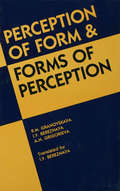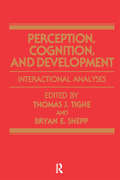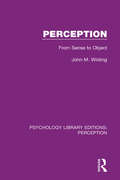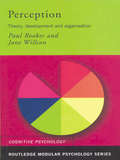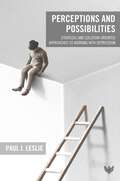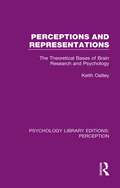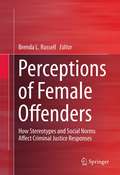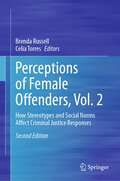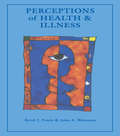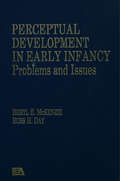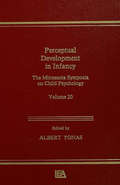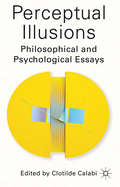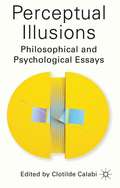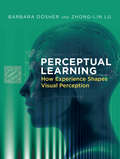- Table View
- List View
Perception as Information Detection: Reflections on Gibson’s Ecological Approach to Visual Perception (Resources for Ecological Psychology Series)
by Jeffrey B. Wagman Julia J. C. BlauThis book provides a chapter-by-chapter update to and reflection on of the landmark volume by J.J. Gibson on the Ecological Approach to Visual Perception (1979). Gibson’s book was presented a pioneering approach in experimental psychology; it was his most complete and mature description of the ecological approach to visual perception. Perception as Information Detection commemorates, develops, and updates each of the sixteen chapters from Gibson’s volume. The book brings together some of the foremost perceptual scientists in the field, from the United States, Europe, and Asia, to reflect on Gibson’s original chapters, expand on the key concepts discussed and relate this to their own cutting-edge research. This connects Gibson’s classic with the current state of the field, as well as providing a new generation of students with a contemporary overview of the ecological approach to visual perception. Perception as Information Detection is an important resource for perceptual scientists as well as both undergraduates and graduates studying sensation and perception, vision, cognitive science, ecological psychology, and philosophy of mind.
Perception as Information Detection: Reflections on Gibson’s Ecological Approach to Visual Perception (Resources for Ecological Psychology Series)
by Jeffrey B. Wagman Julia J. C. BlauThis book provides a chapter-by-chapter update to and reflection on of the landmark volume by J.J. Gibson on the Ecological Approach to Visual Perception (1979).Gibson’s book was presented a pioneering approach in experimental psychology; it was his most complete and mature description of the ecological approach to visual perception. Perception as Information Detection commemorates, develops, and updates each of the sixteen chapters from Gibson’s volume. The book brings together some of the foremost perceptual scientists in the field, from the United States, Europe, and Asia, to reflect on Gibson’s original chapters, expand on the key concepts discussed and relate this to their own cutting-edge research. This connects Gibson’s classic with the current state of the field, as well as providing a new generation of students with a contemporary overview of the ecological approach to visual perception.Perception as Information Detection is an important resource for perceptual scientists as well as both undergraduates and graduates studying sensation and perception, vision, cognitive science, ecological psychology, and philosophy of mind.
Perception of Form and Forms of Perception
by R. M. Granovskaya I. J. Bereznaya Alla N. GrigorievaFirst Published in 1987. Information processing has come to be regarded as one of the central issues in modern psychology. In recent years it has acquired an especially keen interest due to growing amounts of information. This book continues the authors’ research and constructs a conceptual model of peculiarities (separate aspects) of visual information processing based on views similar to those by Arbib and Ivanov.
Perception of Print: Reading Research in Experimental Psychology (Psychology Library Editions: Perception #28)
by Ovid J. L. Tzeng and Harry SingerIn the late 1970s, reading research had become a true interdisciplinary endeavour with flavours of anthropology, artificial intelligence, cognitive psychology, educational psychology, linguistics, neuroscience and instructional technology. Given appropriate integration, results from these diverse perspectives can enhance our understanding of reading behaviour tremendously, both in its acquisition and in its skilled functioning. Thus, the enthusiasm for such interdisciplinary interaction had been quite intense for some time. In the years before publication, the National Reading Conference had been doing everything possible to accelerate this interaction. Originally published in 1981, the chapters in this book are the fruits of that effort. The research focuses on specifying skills in identifying alphabetical elements and the rules that govern their combination, on constructing models that characterize the recognition of individual words and the interpretation of texts, and on discovering what factors are responsible for blocking the normal acquisition process in many children. Chapters 2 to 12 of this book reflect these changing foci. They are nevertheless sandwiched by two chapters that deal with the historical background and future outlook of reading instruction.
Perception, Cognition, and Development: Interactional Analyses
by Thomas J. Tighe and Bryan E. SheppThis volume is based on a conference held at Dartmouth College’s Minary Conference Center in Holdemess, New Hampshire, June 4 -7 , 1981. The conference brought together a number of investigators whose separate lines of inquiry bear in significant ways on the relationships among perception, cognition, and development. The purpose was to consider interactions among these basic processes not only as a critical facet of the research programs of the participants but also as a central conceptual problem for current theoretical psychology. First published in 1983. Routledge is an imprint of Taylor & Francis, an informa company.
Perception, Empathy, and Judgment: An Inquiry into the Preconditions of Moral Performance (G - Reference, Information and Interdisciplinary Subjects)
by Arne Johan VetlesenIn Perception, Empathy, and Judgment Arne Johan Vetlesen focuses on the indispensable role of emotion, especially the faculty of empathy, in morality. He contends that moral conduct is severely threatened once empathy is prevented from taking part in an interplay with cognitive faculties (such as abstraction or imagination) in acts of moral perception and judgment. Drawing on developmental psychology, especially British "object relations" theory, to illuminate the nature and functioning of empathy, Vetlesen shows how moral performance is constituted by a sequence involving perception, judgment, and action, with an interplay between the agent's emotional (empathic) and cognitive faculties occurring at each stage. In the powerful tradition from Kant to present-day theorists such as Kohlberg, Rawls, and Habermas, reason is privileged over feeling and judgment over perception, in such a way that basic philosophical questions remain unasked. Vetlesen focuses our attention on these questions and challenges the long-standing assertion that emotions are damaging to moral response. In the final chapter he relates his argument to recent feminist critiques that have also castigated moral theorists in the Kantian tradition for their refusal to recognize a role for emotion in morality. While the book's argument is philosophical, its method and scope are interdisciplinary. In addition to critiques of such philosophers as Arendt, MacIntyre, and Habermas, it contains discussions of specific historical, ideological, and sociological factors that may cause "numbing"—selective or broad-ranging, pathological insensitivity—in humans. The Nazis' mass killing of Jews is studied to illuminate these and other relevant empirical aspects of large-scale immoral action.
Perception, Learning and the Self: Essays in the Philosophy of Psychology (Routledge Revivals)
by D. W. HamlynFirst published in 1983, Perception, Learning and the Self is a collection of essays demonstrating the incompleteness of the information-processing model in cognitive psychology and the connection between epistemic factors and social conditions in the making of the self. It is suggested that any framework employed to view cognition must be an essentially social one, in which knowers are seen as selves who are agents with feelings and attitudes. Professor Hamlyn argues that, by failing to acknowledge this social element, the information-processing model presents an overly simplistic view of the systems that underlie cognition, and thus is liable to distort what is at stake. Professor Hamlyn considers the contributions of a number of major psychologists to this area of study, including James Gibson, Jean Piaget and Sigmund Freud. This book will be of interest to students of philosophy and psychology.
Perception, Realism, and the Problem of Reference
by Athanassios Raftopoulos Peter MachamerOne of the perennial themes in philosophy is the problem of our access to the world around us; do our perceptual systems bring us into contact with the world as it is or does perception depend upon our individual conceptual frameworks? This volume of new essays examines reference as it relates to perception, action and realism, and the questions which arise if there is no neutral perspective or independent way to know the world. The essays discuss the nature of referring, concentrating on the way perceptual reference links us with the observable world, and go on to examine the implications of theories of perceptual reference for realism and the way in which scientific theories refer and thus connect us with the world. They will be of interest to a wide range of readers in philosophy of psychology, cognitive science and action theory.
Perception: An Annotated Bibliography (Psychology Library Editions: Perception #7)
by Peter Machamer Kathleen EmmettOriginally published in 1976, the bibliography presented here was intended to provide a useful research tool for scholars and students of perception. The primary concentration of the authors’ efforts has been on the philosophical literature during the period of 1935-1974.
Perception: From Sense to Object (Psychology Library Editions: Perception #34)
by John M. WildingOriginally published in 1982, this book introduces the student to the central problem of all perceptual theories: just how does the perceiver identify particular objects? In focusing on the problem, Dr Wilding provides a coherent, well organized framework for its study, bypassing the conventional split between perception and reaction time evidence which was common to most textbooks at the time. The author draws on evidence from a wider number of research traditions and argues that each has a contribution to make to any account of perception. Throughout he emphasizes the methodological basis of the research discussed, in order to provide students with a solid foundation for their own practical work.
Perception: How Our Bodies Shape Our Minds
by Dennis Proffitt Drake BaerA groundbreaking popular psychology book that explores the deep connection between our body and our brain.Over decades of study, University of Virginia psychologist Dennis Proffitt has shown that we are each living our own personal version of Gulliver’s Travels, where the size and shape of the things we see are scaled to the size of our bodies, and our ability to interact with them. Stairs look less steep as dieters lose weight, baseballs grow bigger the better players hit, hills look less daunting if you’re standing next to a close friend, and learning happens faster when you can talk with your hands.Written with journalist Drake Baer, Perception marries academic rigor with mainstream accessibility. The research presented and the personalities profiled will show what it means to not only have, but be, your unique human body. The positive ramifications of viewing ourselves from this embodied perspective include greater athletic, academic, and professional achievement, more nourishing relationships, and greater personal well-being. The better we can understand what our bodies are—what they excel at, what they need, what they must avoid—the better we can live our lives.
Perception: Theory, Development and Organisation (Routledge Modular Psychology)
by Paul Rookes Jane WillsonPaul Rookes and Jane Willson explain perception and perceptual processes in a way that almost anyone can understand. The study of perception, or how the brain processes information from the senses , has fascinated psychologists and philosophers for a long time. Perception takes the key research areas and presents the arguments and findings in a clear, concise form, enabling the reader to have a quick working knowledge of the area.This clear and informative text discusses sensation and perception then looks at theories and explanations of perception. The way visual perception is structured is examined, followed by an analysis of the development of perceptual processes. The authors then consider individual social and cultural variations in perceptual organisation. Perception will be particularly useful to students new to higher-level study. With its helpful textbook features to assist in examination and learning techniques, it should interest all introductory psychology students.
Perceptions and Possibilities: Strategic and Solution-Oriented Approaches to Working with Depression
by Paul J LeslieThis book will assist therapists in easily implementing the concepts of strategic and solution-oriented applications into one's therapeutic work with depressed clients. The focus of these brief therapy approaches is on the clients' resources and potential rather than on their deficits and pathology. These ideas have their roots in the work of Milton H. Erickson, the Mental Research Institute in Palo Alto, California, and Bill O'Hanlon's Solution Oriented Therapy. The methods and applications recognise the significance of how clients perceive their problems, the importance on assisting clients to be validated and understood in the realm of their experiences, and the creation of change in their views and actions concerning their individual situations. Perceptions and Possibilities is designed to assist therapists in finding new ways of moving their therapy sessions away from an entrenched focus on client pathology. Instead, therapists are encouraged towards brief and effective interactions with a focus on future-oriented possibilities. Paul Leslie presents established and cutting-edge research, colourful case studies, and stories told in everyday language to engage, educate, and aid mental health professionals. The aim is to enable them to understand how to easily adapt and apply creative and resourceful therapy interventions to help clients who are suffering from depression. This book is highly recommended for psychologists, counsellors, and psychotherapists, particularly those who are interested in exploring brief therapies, postmodern/Ericksonian approaches, and solution-focused, systemic, and strategic therapies.
Perceptions and Representations: The Theoretical Bases of Brain Research and Psychology (Psychology Library Editions: Perception #24)
by Keith OatleyOriginally published in 1978, this study examines the shortcomings of some theoretical approaches to psychological and neurophysiological mechanisms at the time. Keith Oatley illustrates the extent of these shortcomings by showing how inefficient brain researchers – using their present approaches – would be in trying to understand a computer, which is considerably simpler than the human brain. He concludes that we need better theories than those usually espoused in psychology, and goes on to expound a theory of cognitive representation and inference in perception, which began with Helmholtz more than a hundred years ago but which can now be given substance and formal structure in artificial intelligence programs. The author deploys this theory to give an account of some fundamental problems, such as how we see a three-dimensional world, and how the brain copes so well with incomplete sensory data and with damage to its own components.
Perceptions of Female Offenders
by Brenda RussellFemale offenders are often perceived as victims who commit crimes as a self-defense mechanism or as criminal deviants whose actions strayed from typical 'womanly' behavior. Such cultural norms for violence exist in our gendered society and there has been scholarly debate about how male and female offenders are perceived and how this perception leads to differential treatment in the criminal justice system. This debate is primarily based upon theories associated with stereotypes and social norms and how these prescriptive norms can influence both public and criminal justice response. Scholars in psychology, sociology, and criminology have found that female offenders are perceived differently than male offenders and this ultimately leads to differential treatment in the criminal justice system. This interdisciplinary book provides an evidence based approach of how female offenders are perceived in society and how this translates to differential treatment within the criminal justice system and explores the ramifications of such differences. Quite often perceptions of female offenders are at odds with research findings. This book will provide a comprehensive evidence-based review of the research that is valuable to laypersons, researchers, practitioners, advocates, treatment providers, lawyers, judges, and anyone interested in equality in the criminal justice system.
Perceptions of Female Offenders, Vol. 1: How Stereotypes and Social Norms Affect Criminal Justice Responses
by Brenda Russell Celia TorresThis first volume of the second edition builds on the many developments made to the study of female offenders, compiling new insights and evidence-based research. With new cases such as Amber Heard and Johnny Depp, it further explores topics including the role of social media in how female offenders are portrayed, juvenile offenders, female aggression in young adults, female perpetrators of domestic violence and more. This book begins with new research on gender stereotypes, disruptive behavior, female aggression, the impact of American media and culture, and gender stereotypes and how they relate to female offending. It examines more diverse topics to include greater intersectionality of female perpetrators in terms of age, race, ethnicity, and sexual identity, and country. Additionally, it provides a comprehensive evidence-based review of the research that is valuable to researchers, practitioners, and advocates interested in equality in the criminal justice system.
Perceptions of Female Offenders, Vol. 2: How Stereotypes and Social Norms Affect Criminal Justice Responses
by Brenda Russell Celia TorresThis new edition is a nuanced exploration of female involvement in various crimes—from delinquency, domestic violence, sexual assault and homicide—that resonates with the pulse of contemporary society. In an age where many events are tweeted and debated online, this book delves into the intricate ways social media portrays female offenders and how this can distort public perceptions and effect legal outcomes. Volume two includes recent research and theory examining how female perpetration is intricately related to gender roles that persist within the criminal justice system and often lead to gender disparities in treatment, criminal justice response, and sentencing and calls into question long-held beliefs and systems that might not be as impartial as they appear. The compelling nature of this volume addresses the complex relationship between trauma and offending and examines crucial subjects like partner violence homicide and the unique challenges faced by trans-women within the criminal justice system, and examines the myths associated with female offending and how that bleeds into criminal justice response. It addresses theories that provide insight into female offending and sentencing and offers ways to generate gender inclusiveness. This volume invites researchers, practitioners, and advocates for justice to join a vital conversation and develop a more informed and equitable criminal justice response.
Perceptions of Health and Illness: Current Research And Applications
by Keith J. Petrie John A. WeinmanFirst Published in 1997. The study of how individuals perceive and make sense of health and illness is a new and rapidly developing area in health psychology. The field has seen important recent theoretical developments and applications to a wide range of health threats and illnesses. The first section of this book examines the current theoretical and measurement issues in the field and includes issues related to illness perceptions across the lifespan, disability, and the assessment of illness representations in chronic illness. The second section addresses the role of illness perceptions in health screening and prevention and includes work on perceptions of genetic disease, cancer screening, and how individuals process health risk information. The third section is concerned with the application of the illness perceptions approach to patients with chronic illness and those undergoing treatment. Illnesses examined using this approach include chronic fatigue syndrome, breast cancer, diabetes, and myocardial infarction.
Perceptual Development in Early Infancy: Problems & Issues
by Ross H. Day Beryl E. McKenzieFirst published in 1987. This book is not intended to be either a comprehensive reference work or a systematic handbook on perception in infancy. Nor is it another published report of a recently held conference. It is a collection of state-of-the-art essays on perception during the first year or so of infant development. Rather than first choosing the topics and then finding experts to write about them the editors first chose the experts and invited them to write about those topics in which we know them to be interested and closely involved. The outcome of this approach is a collection of chapters in which the authors at the same time critically review earlier contributions to the topic, report their own work, identify numerous unresolved problems and key issues, and point out directions for future inquiry. Naturally the emphasis placed on these facets varies markedly with both topic and author. The result is a collection of commentaries that we believe to be comprehensive, informative, interesting, and provocative.
Perceptual Development in infancy: The Minnesota Symposia on Child Psychology, Volume 20 (Minnesota Symposia on Child Psychology Series)
by Albert YonasEach year, the Institute of Child Development brings together a group of distinguished investigators who share a common desire to understand the nature of development. The chapters in this volume are based on papers presented at the 20th of this continuing series, the Minnesota Symposia on Child Psychology. The meetings were held October 31 through November 2, 1985, at the University of Minnesota.
Perceptual Illusions: Philosophical and Psychological Essays
by C. CalabiAlthough current debates in epistemology and philosophy of mind show a renewed interest in perceptual illusions, there is no systematic work in the philosophy of perception and in the psychology of perception with respect to the concept of illusion and the relation between illusion and error. This book aims to fill that gap.
Perceptual Illusions: Philosophical and Psychological Essays
by Clotilde CalabiAlthough current debates in epistemology and philosophy of mind show a renewed interest in perceptual illusions, there is no systematic work in the philosophy of perception and in the psychology of perception with respect to the concept of illusion and the relation between illusion and error. This book aims to fill that gap.
Perceptual Intelligence: The Brain's Secret to Seeing Past Illusion, Misperception, and Self-Deception
by Montel Williams Brian Boxer WachlerThe Secret Behind Our Perceptions Finally Revealed!Why do we gravitate to products endorsed by celebrities? Why does time seem to go by faster as we get older? Why are some athletes perpetual winners and others losers? Exploring the brain’s ability to interpret and make sense of the world, Dr. Brian Boxer Wachler describes how your perception can be reality or fantasy and how to separate the two, which is the basis of improving your Perceptual Intelligence (PI). With concrete examples and case studies, Dr. Brian (as he’s known to his patients) explains why our senses do not always match reality and how we can influence the world around us through perceptions, inward and outward. By fine-tuning your PI, you can better understand what’s really going on and make more insightful decisions in your life.
Perceptual Learning: How Experience Shapes Visual Perception
by Zhong-Lin Lu Barbara DosherA comprehensive and integrated introduction to the phenomena and theories of perceptual learning, focusing on the visual domain.Practice or training in perceptual tasks improves the quality of perceptual performance, often by a substantial amount. This improvement is called perceptual learning (in contrast to learning in the cognitive or motor domains), and it has become an active area of research of both theoretical and practical significance. This book offers a comprehensive introduction to the phenomena and theories of perceptual learning, focusing on the visual domain.
Perceptual Organization (Psychology Library Editions: Perception #16)
by Michael Kubovy James R. PomerantzOriginally published in 1981, perceptual organization had been synonymous with Gestalt psychology, and Gestalt psychology had fallen into disrepute. In the heyday of Behaviorism, the few cognitive psychologists of the time pursued Gestalt phenomena. But in 1981, Cognitive Psychology was married to Information Processing. (Some would say that it was a marriage of convenience.) After the wedding, Cognitive Psychology had come to look like a theoretically wrinkled Behaviorism; very few of the mainstream topics of Cognitive Psychology made explicit contact with Gestalt phenomena. In the background, Cognition's first love – Gestalt – was pining to regain favor. The cognitive psychologists' desire for a phenomenological and intellectual interaction with Gestalt psychology did not manifest itself in their publications, but it did surface often enough at the Psychonomic Society meeting in 1976 for them to remark upon it in one of their conversations. This book, then, is the product of the editors’ curiosity about the status of ideas at the time, first proposed by Gestalt psychologists. For two days in November 1977, they held an exhilarating symposium that was attended by some 20 people, not all of whom are represented in this volume. At the end of our symposium it was agreed that they would try, in contributions to this volume, to convey the speculative and metatheoretical ground of their research in addition to the solid data and carefully wrought theories that are the figure of their research.

